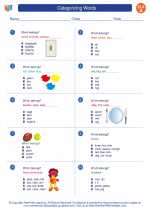Categorizing Words -> conjunctions
Conjunctions Study Guide
A conjunction is a word that is used to connect words, phrases, or clauses in a sentence. Conjunctions are important for joining different parts of a sentence together to make the meaning clear.
Types of Conjunctions
There are three main types of conjunctions: coordinating conjunctions, subordinating conjunctions, and correlative conjunctions.
Coordinating Conjunctions
Coordinating conjunctions connect words, phrases, or independent clauses that are of equal importance within a sentence. The most common coordinating conjunctions are: and, but, or, for, nor, so, and yet.
Subordinating Conjunctions
Subordinating conjunctions introduce dependent clauses and connect them to independent clauses. Some examples of subordinating conjunctions include: because, although, since, while, and if.
Correlative Conjunctions
Correlative conjunctions are used in pairs to connect elements of equal importance within a sentence. Examples of correlative conjunctions include: either/or, neither/nor, both/and, not only/but also.
Examples of Conjunctions in Sentences
1. Coordinating Conjunction: I like tea and coffee.
2. Subordinating Conjunction: I will go for a walk if the weather is nice.
3. Correlative Conjunction: She is neither a doctor nor a nurse.
Practice Exercises
Identify the type of conjunction used in each of the following sentences:
- He wanted to go to the park, but it was raining.
- I will call you when I get home.
- They can either take the bus or walk to school.
Conclusion
Conjunctions play an important role in creating well-structured and cohesive sentences. By understanding and using conjunctions effectively, you can improve the clarity and coherence of your writing.
[Conjunctions] Related Worksheets and Study Guides:
.◂English Language Arts Worksheets and Study Guides First Grade. Categorizing Words

 Worksheet/Answer key
Worksheet/Answer key
 Worksheet/Answer key
Worksheet/Answer key
 Worksheet/Answer key
Worksheet/Answer key
